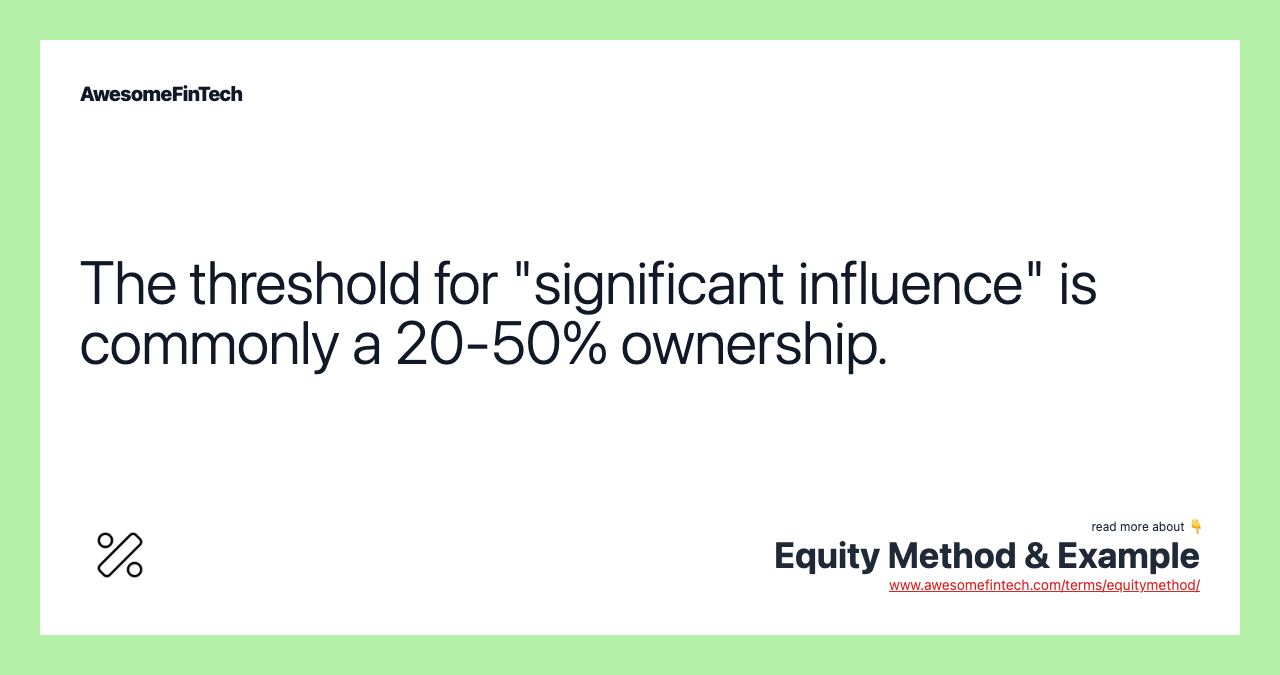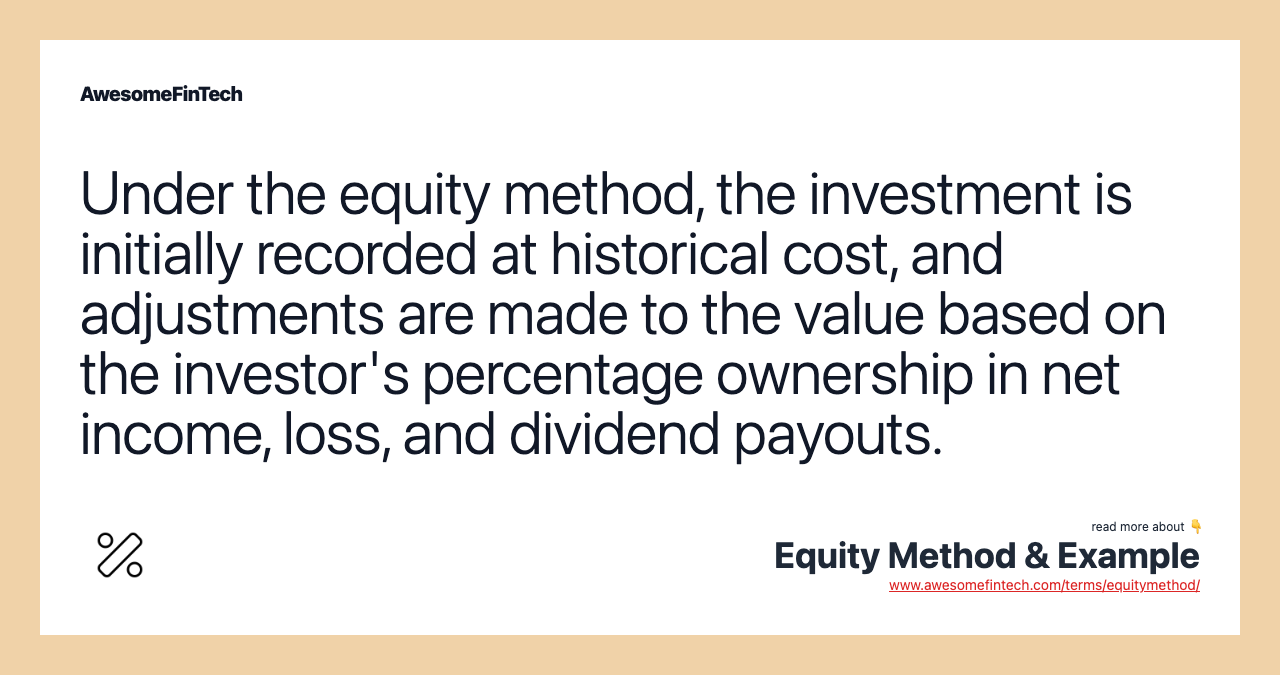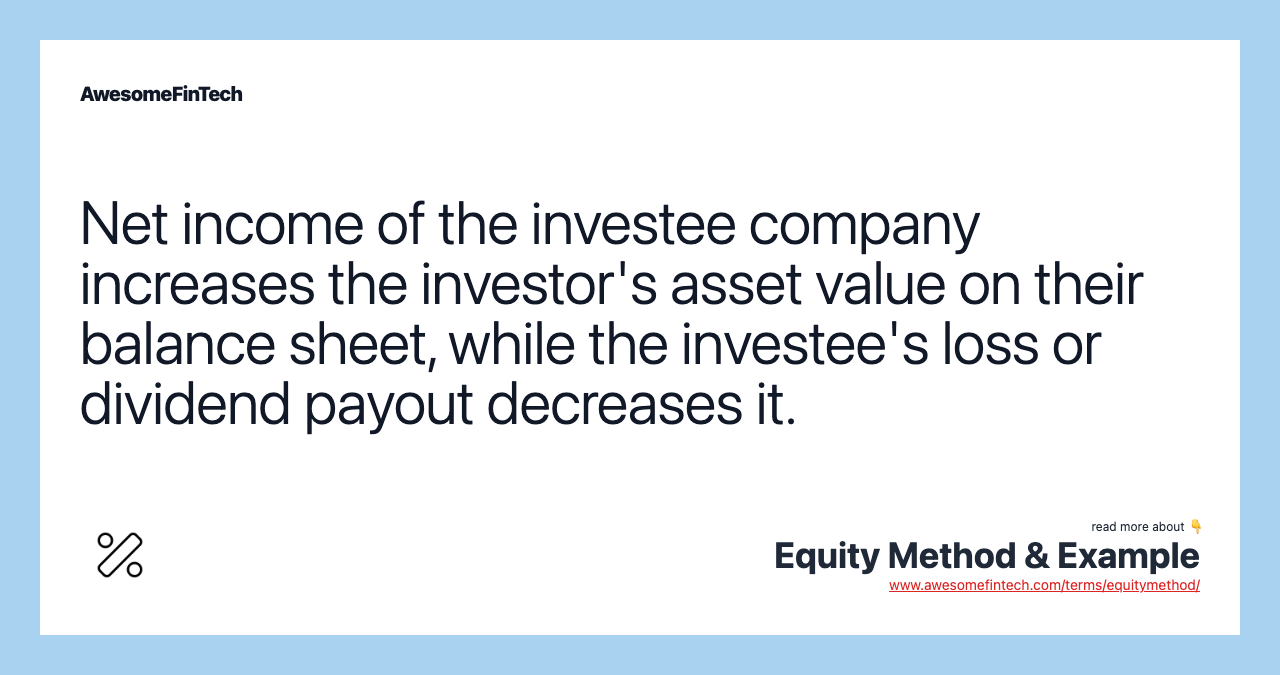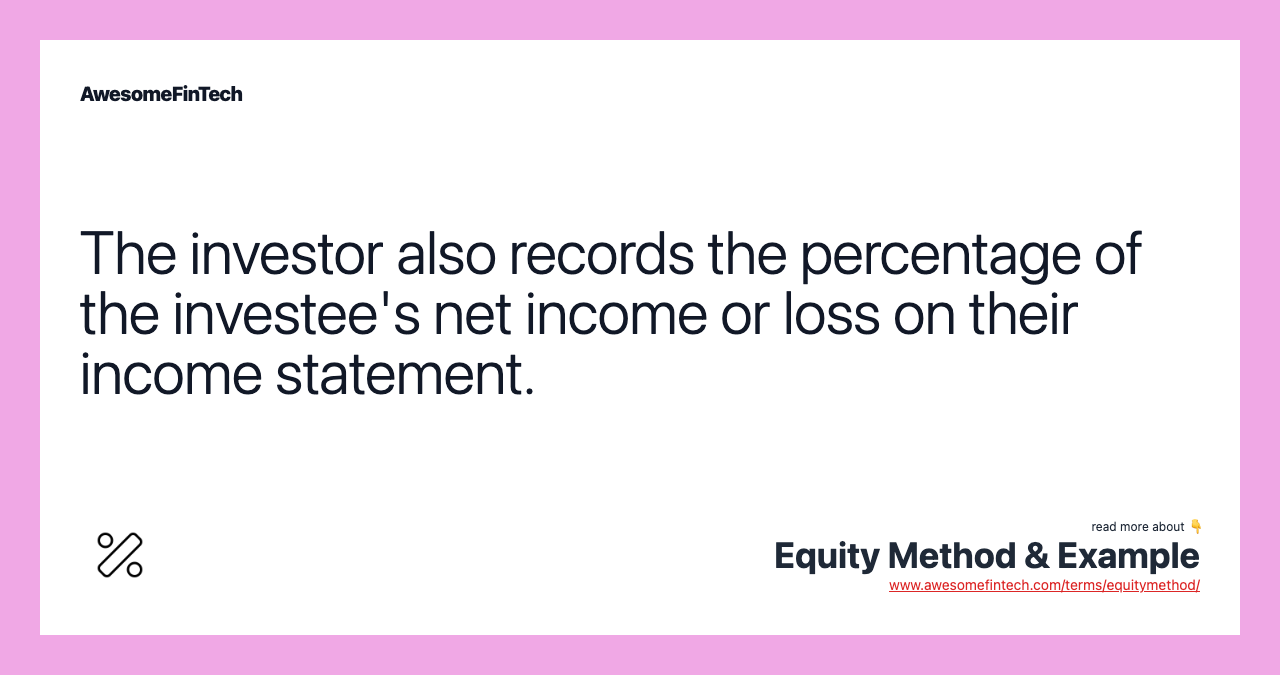Equity Method & Example
Table of Contents What Is the Equity Method? Understanding the Equity Method Revenue Records and Asset Changes With the equity method of accounting, the investor company reports the revenue earned by the other company on its income statement, in an amount proportional to the percentage of its equity investment in the other company. With a significant influence over another company's operating and financial policies, the investor is basing their investment value on changes in the value of that company's net assets from operating and financial activities and the resulting performances, including earnings and losses. The equity method is used to value a company's investment in another company when it holds significant influence over the company it is investing in. Using the equity method, the investor company receiving the dividend records an increase to its cash balance but, meanwhile, reports a decrease in the carrying value of its investment.

What Is the Equity Method?
The equity method is an accounting technique used by a company to record the profits earned through its investment in another company. With the equity method of accounting, the investor company reports the revenue earned by the other company on its income statement, in an amount proportional to the percentage of its equity investment in the other company.





Understanding the Equity Method
The equity method is the standard technique used when one company, the investor, has a significant influence over another company, the investee. When a company holds approximately 20% to 50% of a company's stock, it is considered to have significant influence. Companies with less than 20% interest in another company may also hold significant influence, in which case they also need to use the equity method.
Significant influence is defined as an ability to exert power over another company. This power includes representation on the board of directors, involvement in policy development, and the interchanging of managerial personnel.
Recording Revenue and Asset Changes Under the Equity Method
The equity method acknowledges the substantive economic relationship between two entities. The investor records their share of the investee's earnings as revenue from investment on the income statement. For example, if a firm owns 25% of a company with a $1 million net income, the firm reports earnings from its investment of $250,000 under the equity method.
When the investor has a significant influence over the operating and financial results of the investee, this can directly affect the value of the investor's investment. The investor records their initial investment in the second company's stock as an asset at historical cost. Under the equity method, the investment's value is periodically adjusted to reflect the changes in value due to the investor's share in the company's income or losses. Adjustments are also made when dividends are paid out to shareholders.
Using the equity method, a company reports the carrying value of its investment independent of any fair value change in the market. With a significant influence over another company's operating and financial policies, the investor is basing their investment value on changes in the value of that company's net assets from operating and financial activities and the resulting performances, including earnings and losses.
For example, when the investee company reports a net loss, the investor company records its share of the loss as "loss on investment" on the income statement, which also decreases the carrying value of the investment on the balance sheet.
When the investee company pays a cash dividend, the value of its net assets decreases. Using the equity method, the investor company receiving the dividend records an increase to its cash balance but, meanwhile, reports a decrease in the carrying value of its investment. Other financial activities that affect the value of the investee's net assets should have the same impact on the value of the investor's share of investment. The equity method ensures proper reporting on the business situations for the investor and the investee, given the substantive economic relationship they have.
Example of the Equity Method
For example, assume ABC Company purchases 25% of XYZ Corp for $200,000. At the end of year 1, XYZ Corp reports a net income of $50,000 and pays $10,000 in dividends to its shareholders. At the time of purchase, ABC Company records a debit in the amount of $200,000 to "Investment in XYZ Corp" (an asset account) and a credit in the same amount to cash.
At the end of the year, ABC Company records a debit in the amount of $12,500 (25% of XYZ's $50,000 net income) to "Investment in XYZ Corp", and a credit in the same amount to Investment Revenue. In addition, ABC Company also records a debit in the amount of $2,500 (25% of XYZ's $10,000 dividends) to cash, and a credit in the same amount to "Investment in XYZ Corp." The debit to the investment increases the asset value, while the credit to the investment decreases it.
The new balance in the "Investment in XYZ Corp" account is $210,000. The $12,500 Investment Revenue figure will appear on ABC's income statement, and the new $210,000 balance in the investment account will appear on ABC's balance sheet. The net ($197,500) cash paid out during the year ($200,000 purchase - $2,500 dividend received) will appear in the cash flow from / (used in) investing activities section of the cash flow statement.
Alternative Methods
When an investor company exercises full control, generally over 50% ownership, over the investee company, it must record its investment in the subsidiary using a consolidation method. All revenue, expense, assets, and liabilities of the subsidiary would be included in the parent company's financial statements.
On the other hand, when an investor does not exercise full control or have significant influence over the investee, they would need to record their investment using the cost method. In this situation, the investment is recorded on the balance sheet at its historical cost.
Related terms:
Additional Paid-In Capital (APIC)
Additional paid-in capital is the excess amount paid by an investor above the par value price of a stock during an initial public offering (IPO). read more
Asset
An asset is a resource with economic value that an individual or corporation owns or controls with the expectation that it will provide a future benefit. read more
Balance Sheet : Formula & Examples
A balance sheet is a financial statement that reports a company's assets, liabilities and shareholder equity at a specific point in time. read more
Board of Directors (B of D)
A board of directors (B of D) is a group of individuals elected to represent shareholders and establish and support the execution of management policies. read more
Contra Account
A contra account is an account used in a general ledger to reduce the value of a related account. A contra account's natural balance is the opposite of the associated account. read more
Earnings
A company's earnings are its after-tax net income, meaning its profits. Earnings are the main determinant of a public company's share price. read more
Equity Accounting
Equity accounting is a method of accounting whereby a corporation records a portion of the undistributed profits for an affiliated entity holding. read more
Impairment (Accounting)
Impairment describes a permanent reduction in the value of a company's asset, such as a fixed asset or intangible, to below its carrying value. read more
Indirect Method
The indirect method uses changes in balance sheet accounts to modify the operating section of the cash flow statement from the accrual method to the cash method. read more
Parent Company
A parent company is a maintains a majority interest in another company, giving it control of its operations. read more